In today’s tech-driven world, all the screen time can really tire out my eyes.
Whether I’m working, scrolling through social media, or binge-watching shows, it’s easy to forget how this can impact my eye health. So, I need to maintain good habits to keep my eyes healthy in this digital age.
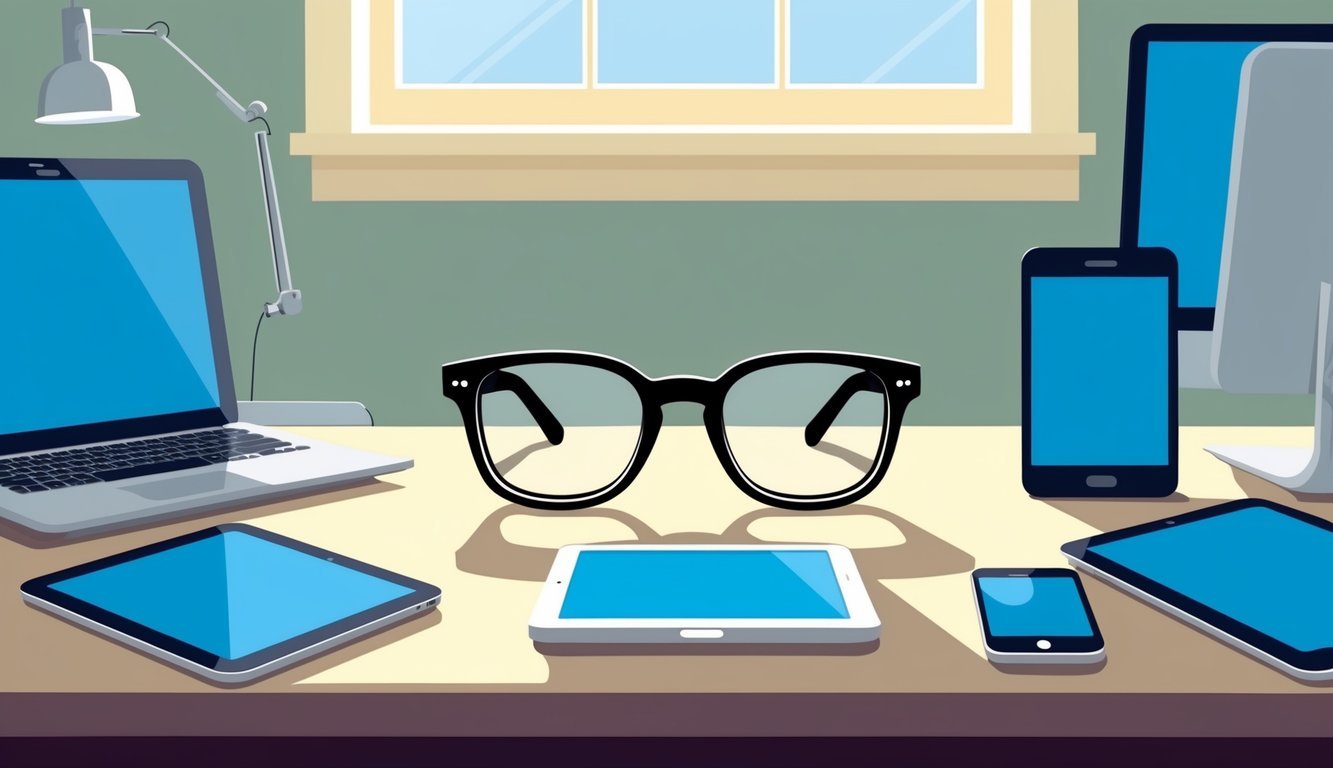
I’ve found that simple adjustments in my routine can help reduce strain and preserve my vision.
With a bit of mindfulness, it’s possible to enjoy all the benefits of technology while still caring for my eyes.
1) 20-20-20 Rule: Look 20 Feet Away Every 20 Minutes
I’ve found that the 20-20-20 rule is a simple yet effective way to take care of my eyes during long hours in front of screens.
The idea is easy: every 20 minutes, I look at something 20 feet away for 20 seconds.
This practice helps relieve eye strain.
When I focus on a distant object, it allows my eye muscles to relax, reducing that tired feeling I sometimes get.
I try to set reminders on my phone to make sure I stick to this routine.
Sometimes, I even use it as a quick break to stretch or get a drink.
Incorporating the 20-20-20 rule into my day has made a noticeable difference.
It’s a helpful tool for preventing digital eye strain while working or browsing online.
Keeping it simple really works for me.
Adjust Your Screen Brightness and Contrast
I often find that adjusting my screen’s brightness and contrast can make a big difference in how my eyes feel throughout the day.
When my screen is too bright or too dim, it can lead to discomfort and strain.
A good starting point is to match the brightness of my screen with the lighting in the room.
If the room is bright, I increase the brightness.
In a dimly lit environment, I lower it.
This balance helps reduce glare and eye fatigue.
Then there’s the contrast.
Higher contrast settings can make text and images clearer, which means less strain when I’m reading or working.
I make sure the contrast is set to a level that feels comfortable for my eyes.
I also pay attention to the specific tasks I’m doing.
For instance, when I’m working on a document, I might adjust the settings to make it more comfortable for reading.
Taking a moment to find the right settings can keep my eyes from feeling tired and strained.
3) Use Computer Glasses with Anti-Reflective Coating
I’ve noticed a real difference since I started using computer glasses with an anti-reflective coating.
These glasses are designed to reduce glare from screens, which can make a huge impact on my comfort during long hours of work.
The anti-reflective coating also helps me see clearly without distractions.
It minimizes the reflections that can bounce off the lenses, letting me focus better on my tasks.
Plus, many of these glasses come with blue light filtering.
This feature is useful for cutting down the eye strain caused by the high-energy light emitted from screens.
I feel less fatigued after a long day.
If you spend a lot of time in front of digital devices, investing in a pair of these glasses may be beneficial.
They’re not just practical; they can be stylish too, which is a nice bonus.
With the right pair, I’m giving my eyes the support they need in this digital age.
4) Blink More Often to Keep Eyes Moist
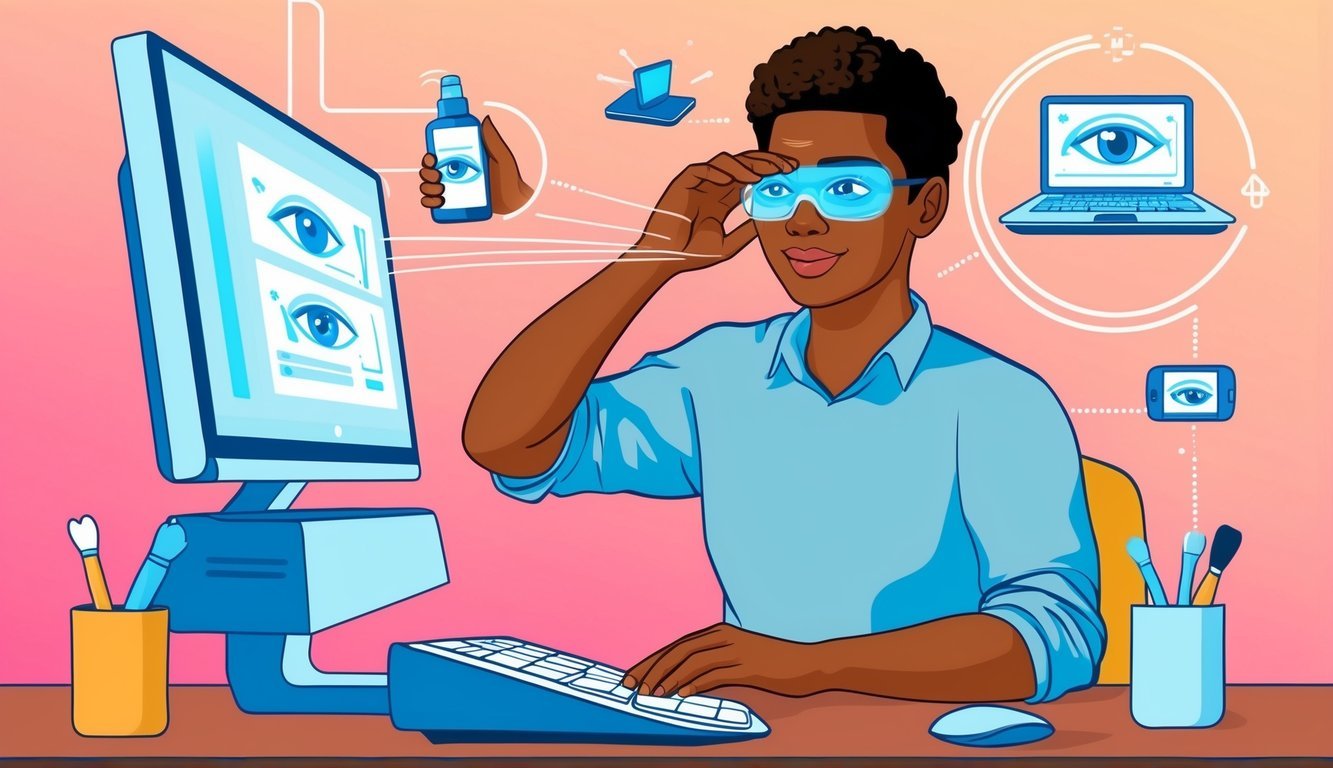
I often catch myself staring at screens for too long without realizing it.
When I do this, my blink rate decreases, which can lead to dry and irritated eyes.
It’s surprising how a simple action can make such a difference.
Blinking is essential for keeping my eyes lubricated.
Each blink spreads tears across the surface of my eyes, forming a protective layer.
If I make a conscious effort to blink more often, I can help prevent dryness.
When I’m focused on work or browsing online, I try to remind myself to take short breaks and blink frequently.
This small habit can reduce discomfort and keep my eyes feeling fresh.
In addition to blinking more, I’ve found that using artificial tears can be beneficial when I know I’ll be spending extended time in front of a screen.
They provide extra moisture and can alleviate dryness.
Staying aware of my blinking habits has become a key part of my routine.
It’s a simple yet effective way to support my eye health in the digital age.
5) Keep Computer Screen Below Eye Level
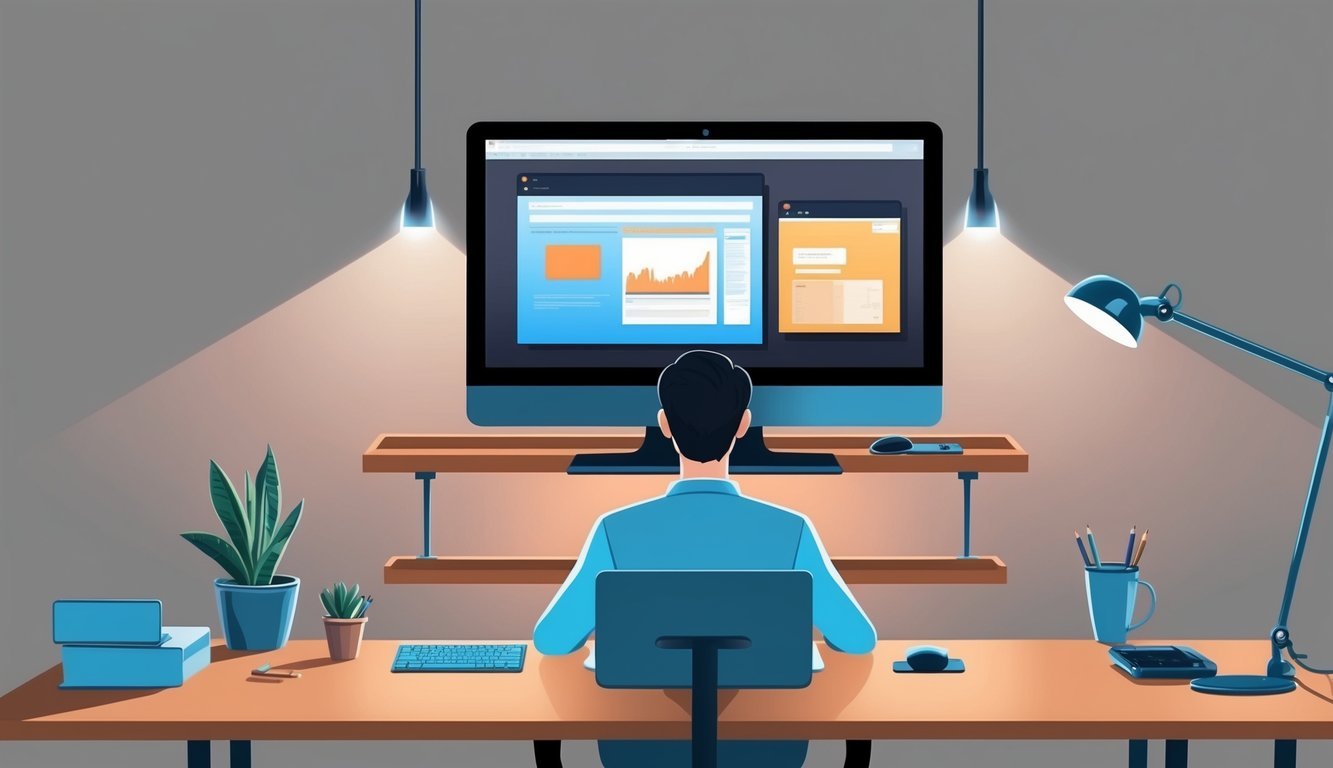
I’ve found that positioning my computer screen a bit lower than eye level makes a noticeable difference.
Ideally, the screen should sit about 4 to 5 inches below where I naturally look.
This simple adjustment helps me maintain a relaxed posture while reducing strain.
Looking down at the computer screen at a 15 to 20-degree angle keeps my eyelids covering more of my eyeballs.
This not only helps shield my eyes from drying out but also feels more comfortable during long hours of work.
Keeping the screen at this height also encourages a more natural sitting position.
When I’m not straining to look upwards, I feel less pressure in my neck and shoulders.
I’ve noticed that making this small change has improved my overall comfort and focus while I work.
It’s an easy tip that can support eye health, especially in our digital age.
6) Follow a Balanced Diet Rich in Omega-3 and Vitamins

Eating a balanced diet is essential for my eye health, especially in this digital age.
I make sure to include omega-3 fatty acids, which are known for their anti-inflammatory properties.
Foods like fatty fish—salmon, mackerel, and sardines—are great sources of these healthy fats.
I also incorporate nuts and seeds into my meals.
These not only provide omega-3s but are also packed with fiber and other nutrients.
A handful of walnuts or flaxseeds can make a difference in my diet.
Vitamins like A, C, and E play a crucial role, too.
I focus on fruits and vegetables such as carrots, spinach, and citrus, which help support my overall eye health.
Sometimes, I consider omega-3 supplements, especially if my diet lacks these nutrients.
I prefer those that include antioxidants, which can provide added benefits.
By keeping my diet diverse and rich in omega-3s and vitamins, I support my eyes against the strain of screens.
7) Take Frequent Screen Breaks

I’ve noticed that taking frequent breaks from my screen makes a big difference in how my eyes feel.
Staring at a digital device for too long can lead to discomfort and fatigue.
I try to follow the 20-20-20 rule.
Every 20 minutes, I take a 20-second break and focus on something at least 20 feet away.
It really helps my eyes relax.
During these breaks, I often close my eyes or blink rapidly.
This simple action keeps my eyes lubricated and reduces dryness.
Another great idea is to step away from my desk completely.
A quick walk or change of scenery can rejuvenate my eyes and boost my productivity.
If I’m feeling particularly strained, I’ll make sure to take longer breaks.
Engaging in non-digital activities allows my eyes to recover and prepare for more screen time.
Incorporating these breaks into my routine not only helps my eyes but also enhances my overall focus throughout the day.
Maintain Proper Lighting to Reduce Glare
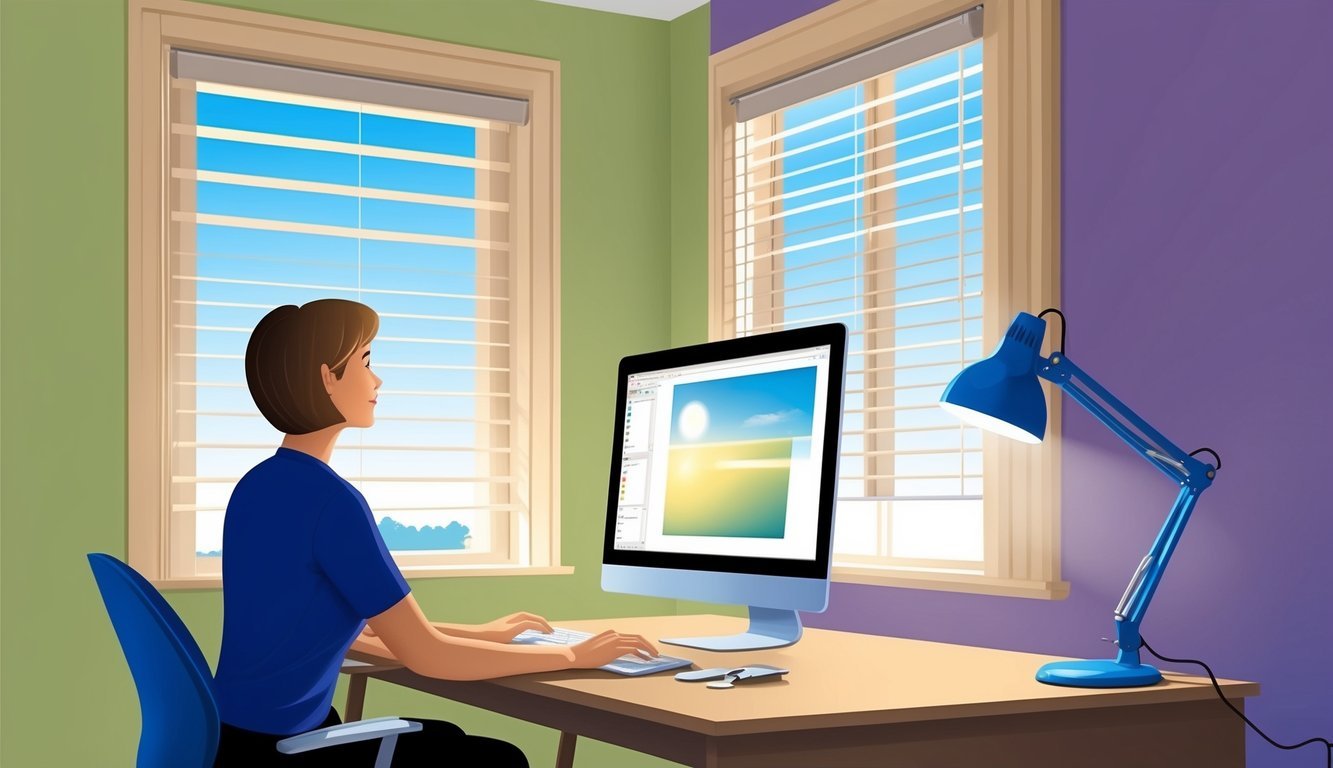
Finding the right lighting in my workspace has made a big difference in my eye comfort.
I’ve learned that harsh overhead lights can cause significant glare on my screen, making it harder to see.
To combat this, I often use soft, indirect lighting.
Desk lamps with adjustable brightness let me focus light where I need it without overwhelming my eyes.
Reducing overhead lighting helps create a more comfortable environment.
Matching the brightness of my screen to the surrounding light is another crucial tip.
If my screen glows brighter than the area around it, my eyes have to work harder, which leads to strain.
I also avoid sitting directly in front of windows, as sunlight can create glare on my screen.
Instead, I position my workspace to allow natural light from the side.
Finally, I keep my workspace organized to eliminate clutter that can block light.
With these simple adjustments, I feel more relaxed and my eyes thank me for it.
9) Stay Hydrated with Ample Water Intake
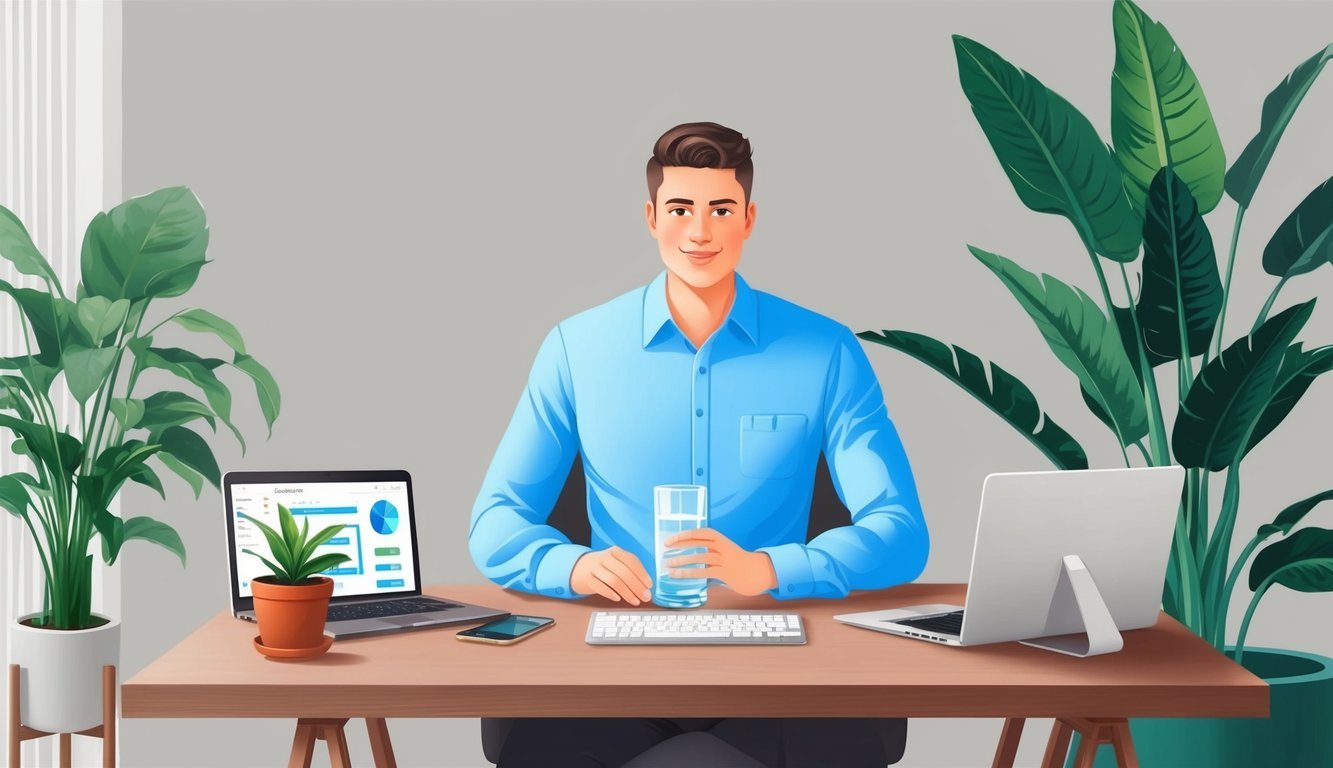
Staying hydrated is crucial for maintaining healthy eyes, especially in our digital world.
I make it a point to drink plenty of water throughout the day.
Dehydration can lead to dry eyes and blurred vision.
I’ve noticed that when I don’t drink enough water, my eyes feel tired and uncomfortable.
I aim for about 8-10 glasses a day.
If I’m active or the weather is hot, I increase my intake to stay balanced.
Additionally, hydration helps reduce puffiness and dark circles.
Proper fluid intake makes a noticeable difference in how my eyes look and feel.
I also enjoy hydrating foods like cucumbers and oranges.
They’re not only tasty but also boost my daily water intake.
Setting reminders to drink water has been helpful for me, especially during long hours on screens.
Keeping a water bottle nearby makes it easy to remember.
This simple habit has improved my eye comfort and overall well-being.
So, I encourage you to stay hydrated for healthier, happier eyes.
Understanding Digital Eye Strain
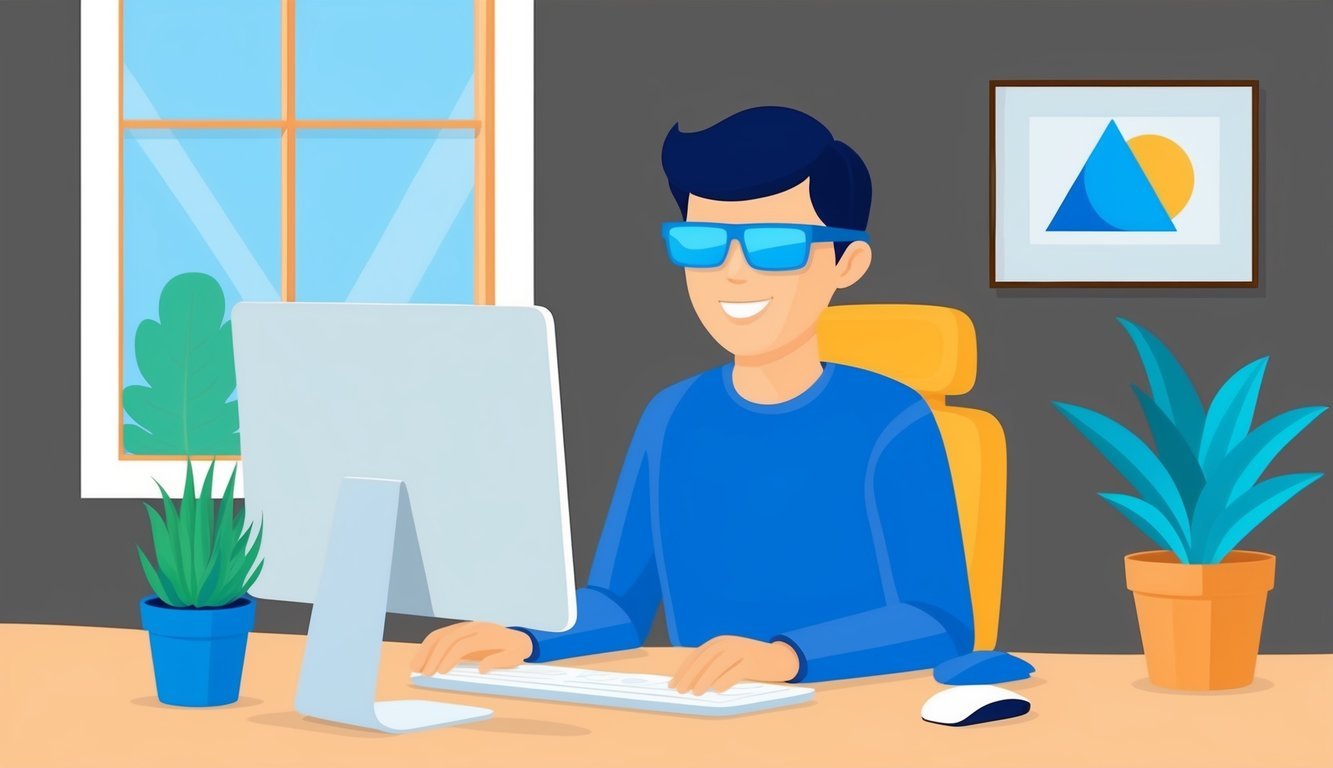
Digital eye strain affects many of us today, especially with prolonged screen usage.
This section will cover the symptoms that may indicate eye strain, as well as the common causes and risk factors involved.
Symptoms of Eye Strain
When I notice my eyes feeling tired or uncomfortable, I often think of digital eye strain.
Some common symptoms include:
- Dry or Irritated Eyes: Spending hours staring at a screen can lead to a sensation of dryness or irritation.
- Blurred Vision: It’s not uncommon for things to look a bit hazy after too much screen time.
- Headaches: I sometimes get dull headaches, especially after long sessions on my computer or phone.
Other symptoms can include neck and shoulder pain.
If I’m consistently experiencing these signs, it’s a clue that I might need to adjust my habits.
Causes and Risk Factors
Several factors can contribute to digital eye strain. Prolonged screen time without breaks is one major cause.
The blue light emitted by screens can also play a role in eye fatigue.
Poor Lighting can intensify strain.
If your workspace is too bright or there’s glare on your screen, your eyes work harder.
Uncorrected Vision Issues can also increase your risk.
If you need glasses or have an outdated prescription, it might lead to discomfort.
Maintaining proper screen distance and reducing glare are vital.
Being aware of these factors can help you take proactive steps to protect your eyes.
Tips for Maintaining Eye Health
Maintaining eye health is crucial, especially in our tech-driven world.
Creating a comfortable workspace and prioritizing regular eye exams can make a significant difference.
Following the best practices for eye health, such as taking frequent screen breaks and adjusting screen brightness, can help reduce eye strain.
Additionally, staying hydrated and consuming a nutrient-rich diet supports long-term vision health.
Creating a Comfortable Workspace
Setting up a workspace that minimizes strain is essential.
I make sure my screen is at eye level, about an arm’s length away.
This position helps reduce the need to lean forward or squint.
Lighting matters too. I prefer natural light whenever possible.
If I must use artificial lighting, I choose soft, warm bulbs to avoid glare.
I also take frequent breaks.
Following the 20-20-20 rule helps.
I look at something 20 feet away for 20 seconds every 20 minutes.
This really helps to alleviate dryness and fatigue.
Additionally, I keep my workspace organized.
A clutter-free area reduces distraction, allowing me to focus better on my tasks.
Importance of Regular Eye Exams
Regular eye exams are a key part of eye health maintenance.
I schedule mine at least once a year, regardless of my vision.
Early detection of issues like glaucoma or macular degeneration is crucial.
During the exam, my eye doctor performs a comprehensive dilated check.
This allows them to view my eye’s health in detail.
It’s the best way to catch problems before they become severe.
Even if I feel fine, these exams are important.
I’ve learned that many eye conditions can develop silently.
Having a professional assess my eye health gives me peace of mind, knowing that I’m taking care of my vision properly.

